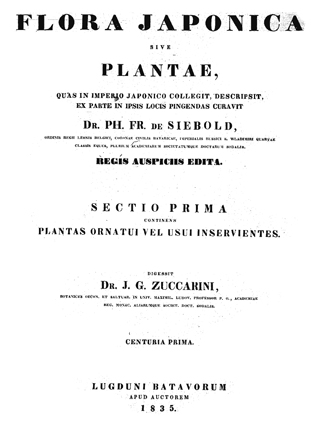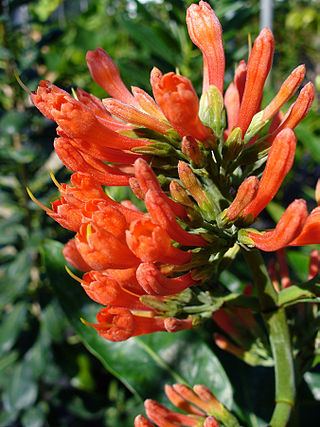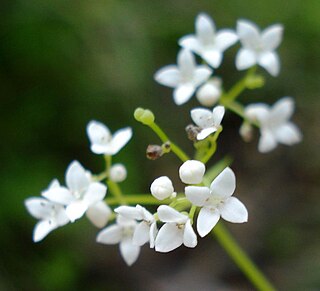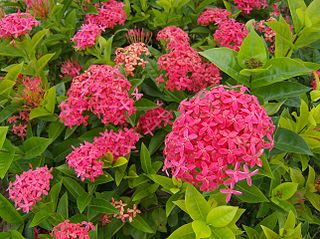
The Rubiaceae are a family of flowering plants, commonly known as the coffee, madder, or bedstraw family. It consists of terrestrial trees, shrubs, lianas, or herbs that are recognizable by simple, opposite leaves with interpetiolar stipules and sympetalous actinomorphic flowers. The family contains about 13,500 species in about 620 genera, which makes it the fourth-largest angiosperm family. Rubiaceae has a cosmopolitan distribution; however, the largest species diversity is concentrated in the tropics and subtropics. Economically important genera include Coffea, the source of coffee, Cinchona, the source of the antimalarial alkaloid quinine, ornamental cultivars, and historically some dye plants.

Uncaria is a genus of flowering plants in the family Rubiaceae. It has about 40 species. Their distribution is pantropical, with most species native to tropical Asia, three from Africa and the Mediterranean and two from the neotropics. They are known colloquially as gambier, cat's claw or uña de gato. The latter two names are shared with several other plants. The type species for the genus is Uncaria guianensis.

Gentianales is an order of flowering plants, included within the asterid clade of eudicots. It comprises more than 20,000 species in about 1,200 genera in 5 families. More than 80% of the species in this order belong to the family Rubiaceae.

Joseph Gerhard Zuccarini was a German botanist, Professor of Botany at the University of Munich. He worked extensively with Philipp Franz von Siebold, assisting in describing his collections from Japan, but also described plants discovered in other areas, including Mexico. Siebold wrote his Flora Japonica in collaboration with Zuccarini. It first appeared in 1835, but the work was not completed until after his death, finished in 1870 by F. A. W. Miquel (1811–1871), director of the Rijksherbarium in Leiden.

Galium is a large genus of annual and perennial herbaceous plants in the family Rubiaceae, occurring in the temperate zones of both the Northern and Southern Hemispheres. Some species are informally known as bedstraw.

Morinda is a genus of flowering plants in the madder family, Rubiaceae. The generic name is derived from the Latin words morus "mulberry", from the appearance of the fruits, and indica, meaning "of India".

Manettia is a genus of flowering plants in the family Rubiaceae. There are between 80 and 123 species. They are distributed in the West Indies, Mexico, and Central and South America. Most are vines. The genus was named after Saverio Manetti.

Balmea is a monospecific genus of flowering plants in the family Rubiaceae containing the single species Balmea stormiae. It is native to El Salvador, Guatemala and Mexico. It is locally known as ayuque. It is conical in shape and used as a Christmas tree in parts of Mexico. Because populations are depleted by this overharvest, this species is threatened with extinction.

Alberta is a monotypic genus of flowering plants in the family Rubiaceae. Most species have been transferred to the genus Razafimandimbisonia, except for the type species Alberta magna. It is native to KwaZulu-Natal, South Africa and is commonly known as Natal flame bush.
Alleizettella is a genus of flowering plants in the family Rubiaceae. It is restricted to southeastern China and northern Vietnam. The genus commemorates French botanist Aymar Charles d'Alleizette.
Blepharidium is a monotypic genus of flowering plants in the family Rubiaceae. The genus contains only one species, viz. Blepharidium guatemalense, which is native to Guatemala, Honduras and southern Mexico. Older works might mention two species.

Bobea is a genus of flowering plants in the family Rubiaceae. All species in this genus are endemic to Hawaii. Bobea was named for Jean-Baptiste Bobe-Moreau by Charles Gaudichaud-Beaupré in 1830 in his book Voyage de l'Uranie.
Robynsia is a monotypic genus of flowering plants in the family Rubiaceae. It was described by John Hutchinson and was named after his friend and colleague Walter Robyns. The genus contains only one species, Robynsia glabrata, which is found in Ghana, Ivory Coast and Nigeria. The species is morphologically similar to the genus Cuviera but differs by having long, slender corolla tubes.

Rudgea is a genus of plant in the family Rubiaceae. it was given it name by Richard Anthony to honour Edward in 1806

Randia, commonly known as indigoberry, is a mostly Neotropical genus of shrubs or small trees in the Rubiaceae. As of February 2022 Plants of the World Online lists a total of 112 accepted species in the genus. Several Australian species have been reassigned to the genus Atractocarpus. These include the garden plants Atractocarpus chartaceus and A. fitzalanii.

Rubieae is a tribe of flowering plants in the family Rubiaceae and contains 970 species in 15 genera. The genus Galium is responsible for more than two thirds of the species in the tribe. The second largest genus is Asperula, which contains about 200 species. Unlike the rest of the family Rubiaceae, the tribe contains predominantly perennial and annual herbs with pseudowhorls of leaves and leaflike stipules and is centered in temperate and tropical-mountain regions.

Vanguerieae is a tribe of flowering plants in the family Rubiaceae and contains about 655 species in 30 genera. It is one of the most species-rich groups within the family and it is distributed across the Paleotropics.

Ixoroideae is a subfamily of flowering plants in the family Rubiaceae and contains about 4000 species in 27 tribes.
Greenea is a genus of flowering plants in the family Rubiaceae. The genus is found from Indo-China to Sumatra. It is named in honor of Benjamin D. Greene.

Dr. Charlotte M. Taylor is a botanist and professor specialising in taxonomy and conservation. She works with the large plant family Rubiaceae, particularly found in the American tropics and in the tribes Palicoureeae and Psychotrieae. This plant family is an economically important group, as it includes plant species used to make coffee and quinine. Taylor also conducts work related to the floristics of Rubiaceae and morphological radiations of the group. Taylor has collected plant samples from many countries across the globe, including Chile, Colombia, Costa Rica, Panama, and the United States of America, and has named many new species known to science from these regions. As of 2015, Taylor has authored 278 land plant species' names, the seventh-highest number of such names authored by any female scientist.
















